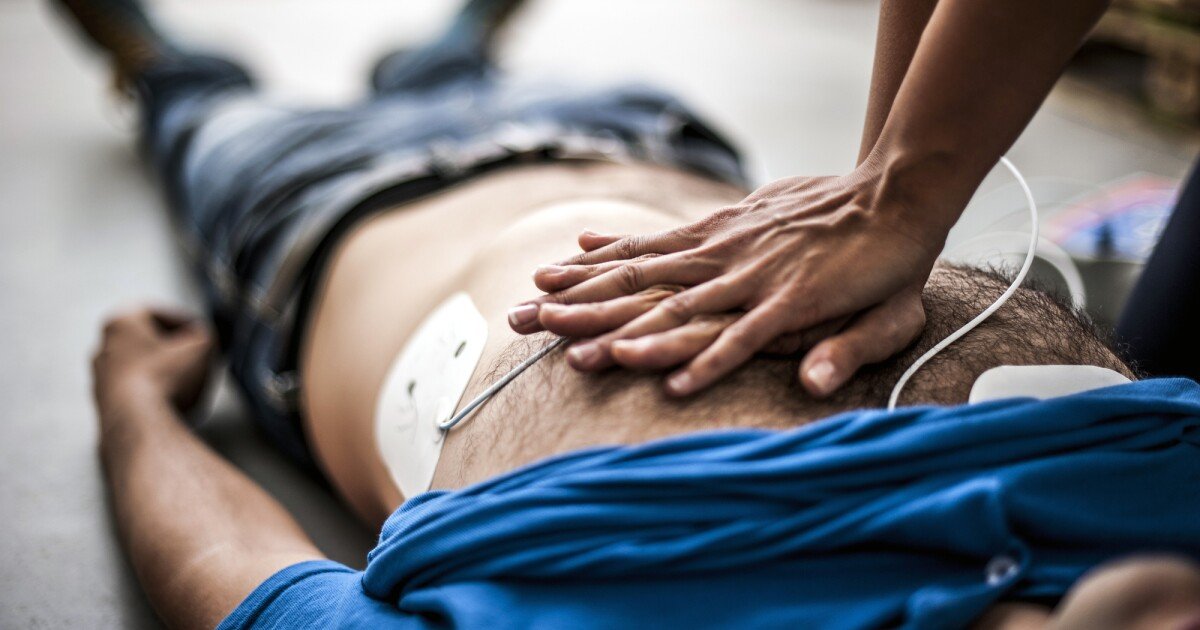A new study finds that applying defibrillation pads to the chest and back, rather than the usual two on the chest, increases survival from out-of-hospital cardiac arrest by more than 2.5 times.
Unfortunately, survival from out-of-hospital cardiac arrest (OHCA) is low. Circulation is restored in 30% of cases, but only 10% survive. However, if the arrest is due to a “shockable” arrhythmia, rapid defibrillation (delivering an electrical shock with electrode pads applied to the chest to shock the heart back into normal rhythm) can improve survival.
Typically, for adults, one defibrillator pad is placed on the right side of the chest, just below the collarbone, and the other on the lower left, under the armpit — known as anterolateral (AL) placement. But could changing the pad placement improve outcomes after cardiac arrest? That’s what researchers investigated in a new study led by Oregon Health & Science University (OHSU).
“The shorter the time in cardiac arrest, the better,” said Joshua Lupton, M.D., assistant professor of emergency medicine at the Oregon Health & Science University School of Medicine and lead author of the study. “The longer the time the brain has low blood flow, the less likely it is to have a good outcome.”
Researchers examined data from the Portland Cardiac Arrest Epidemiology Registry from 2019 to 2023, which comprehensively records defibrillator pad placement locations for OHCA patients with abnormal rhythms, either ventricular fibrillation (VF) or pulseless ventricular tachycardia (pVT).

Heart rhythms associated with cardiac arrest are divided into two groups: shockable (VF or pVT) and non-shockable (asystole and pulseless electrical activity or PEA). In the latter group, administering an electrical shock is ineffective. Cardiac arrest means that the heart’s electrical and mechanical activity has stopped and there is no heartbeat (commonly known as a “flatline”). In PEA, the electrical activity is too weak to pump blood around the body. In shockable rhythms, the heart’s electrical conduction is normal, but the lower chambers of the heart are either contracting too hard to pump blood properly (pVT) or pumping irregularly (VF).
The study included 255 patients with OHCA, with a mean age of 66 years. The researchers looked at defibrillator pad placement and outcomes after defibrillation. The primary outcome was return of spontaneous circulation (ROSC). Thirty-eight percent of patients had pads placed in the AL placement, and 62% had pads placed in the anterior-posterior placement, with one pad placed on the chest above the heart and one on the back. Patients with AP pad placement had a 2.64-fold increased odds of ROSC compared with AL placement.
“The key is that energy travels through the heart from one pad to the other,” said Mohamud Daya, MD, professor of emergency medicine at the Oregon Health & Science University School of Medicine and corresponding author of the study.
The researchers’ findings suggest that “sandwiching” the heart between two defibrillation pads, one in front and one in back, could allow the current to reach a larger area, potentially improving the effectiveness of resuscitation, although they note that AP placement is not always possible.
“It can be difficult to roll someone over,” Daya said. “Paramedics can usually do it, but a layperson might not be able to move the person. It’s also important to get the current going as quickly as possible.”
Lupton, one of the few people to have survived an out-of-hospital cardiac arrest with the help of defibrillation, was pleasantly surprised by the study’s findings.
“We didn’t expect to see such a big difference,” he said, “and this may motivate the medical community to put more research funding into finding out more.”
The study was published in JAMA Network Open.
Source: OHSU













